Posts Tagged ‘Fiona Vella’
-
Safety at sea
Although the sea may be perceived as a barrier, in ancient times, when no infrastructure existed on land, it was actually the medium which connected one country to another. Travelling on the sea had its own risks and so eventually the idea of insuring a ship and its cargo developed. Traces of the first arrangements between merchants date back to the Roman Period, starting from contracts of sea loans and evolving through the centuries into more complex marine insurances.
Along their history, the Maltese Islands often formed part of important trade routes and therefore local merchants were soon involved in this sector of underwriting risks. A wealth of information related to this aspect is available in old documents which show the development of insurance that was offered against particular risks on the sea. Nonetheless, till now, the origins and progress of marine insurance in Malta have been given little attention.
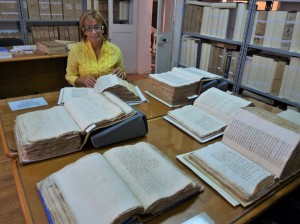 A visit to the Notarial Archives in Valletta where I met historian Dr Joan Abela introduced me to this interesting theme. Always ready to divulge enticing narratives from the valuable sources of these archives, Abela prepared for me a distinguished selection of thick manuscripts in order to help me explore the fine details available within.
A visit to the Notarial Archives in Valletta where I met historian Dr Joan Abela introduced me to this interesting theme. Always ready to divulge enticing narratives from the valuable sources of these archives, Abela prepared for me a distinguished selection of thick manuscripts in order to help me explore the fine details available within.“In antiquity, before marine insurance originated, a sea loan was the only means of transferring risks in maritime transport from the shipper to another person. This consisted of two partners, a traveling and a sedentary one, who pooled their capital in order to invest and share the risk together. With such an agreement, the travelling partner would have more money in hand to work with, whereas the sedentary one would be able to make a profit while staying on land to continue with his work and at the same time avoid the perils that existed out at sea,” explained Abela.
By the Late Middle Ages, as Italian merchants, particularly from Genoa, continued to experiment on these issues of securing vessels and their cargo, marine insurance gradually began to replace this type of agreement.
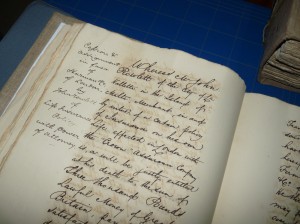 “Since marine insurance was still in its early stages of development, contracts did not adopt a uniform pattern, but varied considerably according to the exigencies of the contractors. Insurance contracts were usually categorized as Securitas by the notary, and were generally divided into two parts.”
“Since marine insurance was still in its early stages of development, contracts did not adopt a uniform pattern, but varied considerably according to the exigencies of the contractors. Insurance contracts were usually categorized as Securitas by the notary, and were generally divided into two parts.”“The first section listed the insurers’ names and the guaranteed premium which was calculated according to the routes, the prevailing conditions along these routes, the type of cargo, and also the type of ship being used. It also covered the kind of information which was regarded as essential for such a contract, that is, the name of the persons insured, specific details regarding the ship which was to undertake the venture, and other specifications regarding the merchandise and its destination. The second part of the contract usually listed the obligations of the insurers, the rights of those insured, and the method of payment.”
 Abela guided me through the Latin elegant black ink scripture which dated to centuries ago. Interestingly, at the beginning of some contracts, prior to the insertion of the usual stereotyped clauses, notaries included an invocation of God’s blessing for a safe trip.
Abela guided me through the Latin elegant black ink scripture which dated to centuries ago. Interestingly, at the beginning of some contracts, prior to the insertion of the usual stereotyped clauses, notaries included an invocation of God’s blessing for a safe trip.‘Al nome De Dio bon viaggio et salvamento Amen’ started a contract dated May 1558.
“Divinity was also cited in other parts of the contracts,” revealed Abela. “In fact, the listing of the perils was often preceded by the phrase che Dio non voglia.”
Abela noted also that although at the time, mariners had a great devotion for the Virgin Mary which is evident from ex-voto paintings, Her name and also the names of saints were not usually mentioned when appealing for such spiritual protection in between legal phrases. This contrasted with the names given to ships that were often named after the Madonna and various saints.
“Indeed these manuscripts can shed light on various subject matters. Amongst the wide data available, one can note the different vessels that were used during the different periods, the names of these ships, the ports to which they travelled, the type of cargo that was carried, and the amount of money which was being insured on it.”
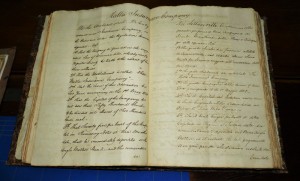 “An insurance contract which was concluded on 4 April 1536 stated that the insurance policy covered a shipment of 18 cantari of spun cotton that was going to be loaded from Birgu and shipped to Licata on the fusta of Giacomo Bonnichi. This fusta was to be captained by Paolo Xuejl or by any other captain appointed in his stead, and was secured to travel to any port which may have been deemed necessary for the purpose of the expedition.”
“An insurance contract which was concluded on 4 April 1536 stated that the insurance policy covered a shipment of 18 cantari of spun cotton that was going to be loaded from Birgu and shipped to Licata on the fusta of Giacomo Bonnichi. This fusta was to be captained by Paolo Xuejl or by any other captain appointed in his stead, and was secured to travel to any port which may have been deemed necessary for the purpose of the expedition.”Interestingly, a clause in the above contract stated that although being insured, the captain was expected to act prudently and to behave as if he was not being offered this protection, in order not to compromise the safety of the merchandise.
“Should any damage or loss occur to the insured goods, the insurers were usually expected to pay the amount insured without any objection within four months from the incident. Yet as we can see from some documents, such as the petition that was put forward by Nob. Giacomo Bonichi against Mag. Pietro Ros and Giovanni Exatopolo in relation to a contract enrolled in the acts of notary Vincenzo Bonaventura de Bonetiis in 1560, the clients were not always satisfied with the way in which claims were met.”
Abela pointed out to a most interesting contract which referred to an insurance of a consigment of apothecary products for the Order’s Infirmary. The list of products acted almost as a showcase of those ingredients which the Hospitallers used in order to produce the required medicine for their patients.
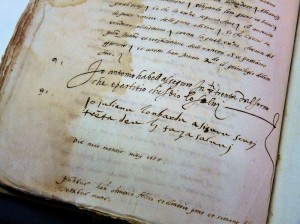 “Those who succeeded to establish themselves in this sector had to have great entrepreneurial skills since this business was still in its infancy and there were lots of risks which one had to deal with. Antonio Habell and Giuliano Lombardo were two of the earliest local entrepreneurs who besides being merchants and traders, they also offered marine insurance services, as may be noted in an insurance contract which they endorsed in respect of the safe consignment of a shipment of timber from Licata in 1558.”
“Those who succeeded to establish themselves in this sector had to have great entrepreneurial skills since this business was still in its infancy and there were lots of risks which one had to deal with. Antonio Habell and Giuliano Lombardo were two of the earliest local entrepreneurs who besides being merchants and traders, they also offered marine insurance services, as may be noted in an insurance contract which they endorsed in respect of the safe consignment of a shipment of timber from Licata in 1558.”Abela lead me to the book Trade and Port Activity in Malta 1750-1800 (2000) by John Debono where one can find detailed research related to aspects of marine insurance.
“As Debono elucidates, marine risks involved were numerous and included: inconsistency in the weather, the questionable conduct of a crew which was generally poorly and irregularly paid and usually comprised men who could not find work ashore, plundering or being taken as a slave by pirates, the unreliability of basic sea charts and portolani which only showed the depth of the water, and the perils that war brought with it.”
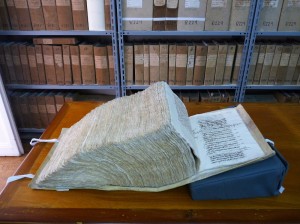 This study underlines also that initially, undewriters operated on an individual basis up to circa 1771, and those notaries which succeeded did very well financially. From an examination of insurance policies between September 1754 and August 1755 drawn up by notary Agostino Marchese, who at the time was most renowned with underwriters and insured, reveals that no less than 109 marine underwiters during that period insured a total sum of 686, 385 scudi against marine risks. However, by the 1770s individual undewriters were being replaced by insurance firms and in 1771, we see the establishment of the first insurance company in Malta.
This study underlines also that initially, undewriters operated on an individual basis up to circa 1771, and those notaries which succeeded did very well financially. From an examination of insurance policies between September 1754 and August 1755 drawn up by notary Agostino Marchese, who at the time was most renowned with underwriters and insured, reveals that no less than 109 marine underwiters during that period insured a total sum of 686, 385 scudi against marine risks. However, by the 1770s individual undewriters were being replaced by insurance firms and in 1771, we see the establishment of the first insurance company in Malta.A few years later, the Maltese Islands were in a state of turmoil as they were briefly occupied by the French and this led to a total collapse of the whole local insurance system. A new chapter in this sector initiated with the beginning of the British rule.
(This article was published in the Shipping and Logistics Supplement which was issued with the Times of Malta on 30th March 2016)
-
Take me to church
“ ‘They have hit our church!’ cried a man as he stumbled down in the tunnel which was located under the Mall Garden. We were huddling in there for shelter together with many other people as the bombs came down over Floriana,” reminisced Pawlu Piscopo who was eight at the time.
 “At this horrible news, my father grabbed me and my brother by the hand and took us out of the tunnel and over to the granaries where a very sad spectacle awaited us. St Publius’ Church had suffered a direct hit. Its dome was gone and the area was surrounded in rubble. Thirteen people who were taking cover in the church’s crypt were killed and eleven more were injured. That was the blackest moment in the history of the parish church of Floriana: April 28, 1942 at 7:50am.”
“At this horrible news, my father grabbed me and my brother by the hand and took us out of the tunnel and over to the granaries where a very sad spectacle awaited us. St Publius’ Church had suffered a direct hit. Its dome was gone and the area was surrounded in rubble. Thirteen people who were taking cover in the church’s crypt were killed and eleven more were injured. That was the blackest moment in the history of the parish church of Floriana: April 28, 1942 at 7:50am.”After their house had been bombed, Pawlu’s family were allowed to take some respite in a large residence which today houses the Floriana Local Council. Yet for four years, they lived mostly underground in this tunnel which probably saved their lives. They took with them only a few belongings and the most cherished items, including a statue of St Publius which dated back to 1928 and used to adorn the model altar that his father had constructed at home.
“Most families in Malta had a model of an altar or a miniature church at home at the time. Unfortunately, many of these had to be abandoned during the war and a good number of them were destroyed when the houses were bombed.”
The craft of church model-making had been introduced to our islands by the Knights of St John back in the 16th century, and therefore its knowledge was a distinct tradition. However the adversity of war ravaged even this precious memory until eventually this craft was almost completely forgotten.
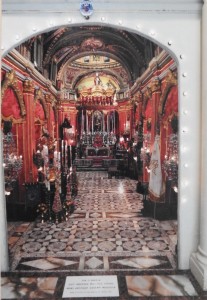 “After the war, people tried to get on with their lives as best as they could. Shops started to open again but those that used to sell miniature items with which to decorate our religious models, dwindled down to almost none. Nevertheless, the passion for model-making was much engrained in our family and when I bought a miniature structure made of four columns and a dome from a man who was leaving Malta to go to live in Australia, my father Carmelo was inspired to use it as the foundation for a model of St Publius’ church,” explained Pawlu.
“After the war, people tried to get on with their lives as best as they could. Shops started to open again but those that used to sell miniature items with which to decorate our religious models, dwindled down to almost none. Nevertheless, the passion for model-making was much engrained in our family and when I bought a miniature structure made of four columns and a dome from a man who was leaving Malta to go to live in Australia, my father Carmelo was inspired to use it as the foundation for a model of St Publius’ church,” explained Pawlu.Carmelo was a very skilled carpenter. He would go from time to time to have a look at the church and then go back to his model and construct an exact copy of the section that he had seen.
“He used the material which was handy at the time, mostly cardboard, wood and gypsum. I helped him out too in order to build the whole church which included ten altars. Eventually, this model reached a huge size of three by four metres and we could walk in it and look above at the beautiful dome,” Pawlu said proudly.
Once his father grew old, Pawlu continued with the work on this church which they had started back in the early 1960s. As he embellished this model, the wish to set up a group for model-makers in order to share this passion with them, burnt within him.
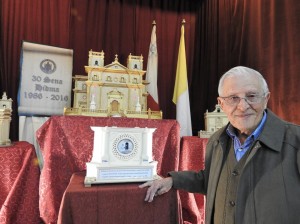 “On February 26, 1986 which happenned to be the tenth anniversary of my father’s demise, I discussed this idea with two of my friends, Raphael Micallef and Tony Terribile, who were very interested in this sector. We all agreed to do something in order to revive this craft and we sent out adverts in the newspapers to announce the set up of this group which we called Għaqda Dilettanti Mudelli ta’ Knejjes (Church Modelling Society). We were very happy when we received a great response from enthusiastic individuals all over Malta. Soon, a commitee was formed and on March 1986, we organized the first exhibition during the first two weeks of Lent wherein the members displayed the works that they had.”
“On February 26, 1986 which happenned to be the tenth anniversary of my father’s demise, I discussed this idea with two of my friends, Raphael Micallef and Tony Terribile, who were very interested in this sector. We all agreed to do something in order to revive this craft and we sent out adverts in the newspapers to announce the set up of this group which we called Għaqda Dilettanti Mudelli ta’ Knejjes (Church Modelling Society). We were very happy when we received a great response from enthusiastic individuals all over Malta. Soon, a commitee was formed and on March 1986, we organized the first exhibition during the first two weeks of Lent wherein the members displayed the works that they had.”It was certainly a great satisfaction to see this society thrive and grow along the years, always adding up new members of various ages. Today, around 400 members form part of this group which operates from its premises at 37, East Street, Valletta.
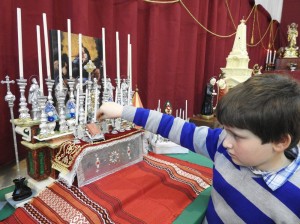 “This year we are delighted to celebrate the 30th anniversary from the establishment of this society,” Pawlu said. “The annual exhibition has been taking place each year. Besides offering the opportunity to showcase our members’ works, this event has served to help our members and the public which visits it, to meditate during the Lent period and to prepare for the Easter celebrations.”
“This year we are delighted to celebrate the 30th anniversary from the establishment of this society,” Pawlu said. “The annual exhibition has been taking place each year. Besides offering the opportunity to showcase our members’ works, this event has served to help our members and the public which visits it, to meditate during the Lent period and to prepare for the Easter celebrations.”A bi-monthly magazine, Il-Knisja Tiegħi (My Church), which was also initiated by Pawlu, is marking its 30th anniversary too. Members have been writing features in it related to different aspects of religious folklore, thereby kindling even further interest in model-making.
Once again this year, the society has organized this exhibition which saw the participation of several of its members. Exhibits varied and included small to large statues of the passion of Christ and Easter, statues of Blessed Mary and several saints, models of altars, church facades and whole churches made of different materials.
 “I hope that I’ll have enough strength to exhibit my large model of St Publius’ church,” revealed Pawlu at one point. “It takes me four weeks to set it up on a large platform and to connect the miniature chandeliers and light fittings to electricity. I am getting old now and such work is very tiring.”
“I hope that I’ll have enough strength to exhibit my large model of St Publius’ church,” revealed Pawlu at one point. “It takes me four weeks to set it up on a large platform and to connect the miniature chandeliers and light fittings to electricity. I am getting old now and such work is very tiring.”Pawlu has been exhibiting this model in a building besides the Floriana Cathecism Museum for many years now, during the feast of St Publius which takes place two weeks after Easter.
“Many people come to visit my model and they are fascinated with it. Tourists take photos besides it and they ask me how I managed to construct it section by section and yet making it look as a whole. I tell them that there are lifetimes of passion invested within it and that it is imbued with a blend of religious meaning and local traditional skills and creativity.”
At 82 years, Pawlu is serene and thankful to see the society which he has founded together with his friends strengthen itself and adding members to it.
“I just wish that it will continue to flourish for very long,” smiled Pawlu as he looked contentedly around him in order to appreciate the beautiful displayed works of the society’s members.
(This article was published in the Easter Supplement which was issued with The Times of Malta dated 21st March 2016)
-
Guests to history
One would probably spare only a few moments of consideration at the receipt of a wedding invitation. However, for Baron Igino de Piro d’Amico Inguanez, these endearing solicitations were cherished so much that he kept a collection of them, neatly separated according to their date and wrapped up together by a string.
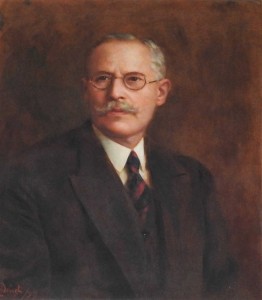 “Were it not for my grandfather’s interest to keep these wedding invitations, we would have lost this fascinating information which can be unravelled within each one of them,” remarked Marquis Nicholas de Piro as we walked towards an elegant table in one of the rooms at Casa Rocca Piccola where he had layed out a number of these invitations.
“Were it not for my grandfather’s interest to keep these wedding invitations, we would have lost this fascinating information which can be unravelled within each one of them,” remarked Marquis Nicholas de Piro as we walked towards an elegant table in one of the rooms at Casa Rocca Piccola where he had layed out a number of these invitations.I glanced out at the wide selection of wedding invitations tastefully set on the polished wooden surface, noticing the different sizes, shapes, writing, designs and paper. The earliest ones dated back to 1815, 1829 and 1832. They were quite plain and small, slightly bigger than a credit card, and written in Italian.
“Here are two of the prettiest ones” said the Marquis as he pulled them out of the rest.
These two invitations had been issued at the end of the 19th century. They were larger than the earlier ones and were quite different from each other. The one dated June 1896 was elegantly designed with an intricate cross at its corner and consisted of an invitation to the wedding between the noble Maria de Piro and Dr. Alfredo Stilon. The other one dated October 1899 was more colourful and rather than an invitation, it was more an announcement of the wedding which was to take place between the noble Maria Teresa de Piro and the Marquis Paolo Apap Bologna. Once again, both were written in Italian.
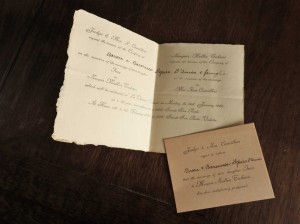 “Now look at this note which accompanies this wedding invitation,” said the Marquis as he handed it to me.
“Now look at this note which accompanies this wedding invitation,” said the Marquis as he handed it to me.The presentation of this wedding invitation was simpler than the previous two and the writing was in English. Here, Judge and Mrs L Camilleri were requesting the company of Baron and Baroness I de Piro d’Amico Inguanez and family to the wedding of their noble daughter Inez to Marquis Mallia Tabone on 26th January 1920. Yet this celebration was not destined to take place as a smaller card which was sent some days later informed those invited that this wedding had been indefinitely postponed.
 “From these invitations, one can also observe the traditional customs of the various eras. For example, this wedding invitation dated 1935 shows clearly that people who chose to get married during the period of Lent had to abide to some limitations.”
“From these invitations, one can also observe the traditional customs of the various eras. For example, this wedding invitation dated 1935 shows clearly that people who chose to get married during the period of Lent had to abide to some limitations.”Indeed, a formal note which was inserted together with the wedding invitation that was sent by Chev & Mrs E Moore and Mrs H Xuereb to announce the marriage of their daughter Alice Moore to Godfrey Xuereb, provided this information with direct instructions:
‘It is much regretted that in view of the restrictions imposed by Canon Law for weddings held in Lent, only a few guests may attend the religious ceremony at the Archbishop’s Palace.
You are therefore invited to meet the bride and bridegroom immediately after the ceremony at the residence at 4:00pm.’
 As we followed the different invitations that were sent along the years to Baron Igino and his family, we could also trace some of his friends and acquaintances, their residences, the chapels and churches where the marriages took place, and the selected locations for the wedding receptions. Although many of the churches still exist today, some of the street names had changed from Italian to English or were altered completely. A number of the residences mentioned have become quite renowned today whilst a few others were turned into commercial properties. Sadly, some of the lovely villas which provided exquisite entertainment in the bygone days were demolished to make place for large modern complexes.
As we followed the different invitations that were sent along the years to Baron Igino and his family, we could also trace some of his friends and acquaintances, their residences, the chapels and churches where the marriages took place, and the selected locations for the wedding receptions. Although many of the churches still exist today, some of the street names had changed from Italian to English or were altered completely. A number of the residences mentioned have become quite renowned today whilst a few others were turned into commercial properties. Sadly, some of the lovely villas which provided exquisite entertainment in the bygone days were demolished to make place for large modern complexes.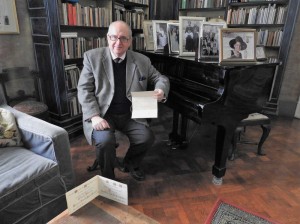 Amongst these, there was the wedding between Hilda Scicluna and Paymaster Lieutenant W Eric Brockman that took place on 4th March 1928. Their marriage was celebrated at the Archbishop’s Palace in Valletta which seems to have been quite a popular venue for such occasions. On the other hand, the reception was held at the bride’s parents residence that was located at 86 Strada Merkanti Valletta; a house which originally belonged to Sir Oliver Starkey, Bali of Aquila and Latin Secretary to Grand Master La Valette. Being an English Knight, he had assisted the Grand Master during the Great Siege of 1565 and was later given the privilege to be buried in the crypt of the Co-Cathedral of St John in Valletta, close to La Valette’s own burial place.
Amongst these, there was the wedding between Hilda Scicluna and Paymaster Lieutenant W Eric Brockman that took place on 4th March 1928. Their marriage was celebrated at the Archbishop’s Palace in Valletta which seems to have been quite a popular venue for such occasions. On the other hand, the reception was held at the bride’s parents residence that was located at 86 Strada Merkanti Valletta; a house which originally belonged to Sir Oliver Starkey, Bali of Aquila and Latin Secretary to Grand Master La Valette. Being an English Knight, he had assisted the Grand Master during the Great Siege of 1565 and was later given the privilege to be buried in the crypt of the Co-Cathedral of St John in Valletta, close to La Valette’s own burial place.The Cathedral in Mdina seems to have been another prominent place for marriages. On 24th January 1937, Adelina Maempel was married to Edwin England Sant Fournier. A reception followed at Villa Luginsland in 26 Boschetto Road, Rabat; a lovely villa which was built by Baron Max von Tucker, the German consul who was serving in Malta in the early 20th century. Unfortunately in recent years years, this remarkable place was in an abandoned state and had a haunting atmosphere.
 The only wedding invitation which came from Gozo looked quite distinguished and it boasted a silver wax seal. The marriage of Carmela and Paul Vella took place on 4th August 1937 and their reception was organized at the Duke of Ediburgh Hotel in Victoria, Gozo. Alas, in recent years, this splendid hotel that was beautifully constructed in Victorian architecture was demolished in order to make way for a commercial centre and a number of residential units.
The only wedding invitation which came from Gozo looked quite distinguished and it boasted a silver wax seal. The marriage of Carmela and Paul Vella took place on 4th August 1937 and their reception was organized at the Duke of Ediburgh Hotel in Victoria, Gozo. Alas, in recent years, this splendid hotel that was beautifully constructed in Victorian architecture was demolished in order to make way for a commercial centre and a number of residential units.“As you have already noted, some of these wedding invitations pertained to our relatives. Incidentally, this one which announces the marriage between my aunt Mona de Piro to Major John E J Nelson on 28th December 1940 is a favourite of mine, particularly because she was quite a character and she kept her high spirits even when she was aged more than ninety. Well, she’s there, looking at us!” the Marquis exclaimed as he pointed to a delightful portrait on the opposite wall.
My eyes met with those of a young, graceful girl, defiantly posing with an off-the-shoulder silver dress which melted in the greyish background behind her.
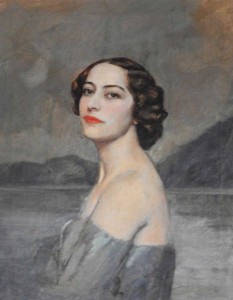 “That portrait created much talk when her relatives saw it since it was regarded too sensual at the time. It was commissioned by her Italian boyfriend, Marquis Onofrio Bartolini Salinbeni, and the painting was done by Arthur Acton who lived in a palace in Florence. Onofrio was madly in love with Mona but unfortunately, their relationship ended and when she returned to Malta, a relative of hers went to Italy to claim this painting since it was not deemed fit for him to keep it,” smiled the Marquis as he went to add some logs to the fire burning in the stylish hearth besides us.
“That portrait created much talk when her relatives saw it since it was regarded too sensual at the time. It was commissioned by her Italian boyfriend, Marquis Onofrio Bartolini Salinbeni, and the painting was done by Arthur Acton who lived in a palace in Florence. Onofrio was madly in love with Mona but unfortunately, their relationship ended and when she returned to Malta, a relative of hers went to Italy to claim this painting since it was not deemed fit for him to keep it,” smiled the Marquis as he went to add some logs to the fire burning in the stylish hearth besides us.A warm gush of air embraced the room as the logs protested and cracked and poured a glowing light over the wedding invitations lying in front of us. For a short spell, I thought that I could hear the tinkling of the glasses filled with red velvety wine and golden sizzling champagne as the guests toasted to the newly married couples.
(This article was published in the Weddings Supplement issued with The Sunday Times of Malta dated 13th March 2016)
-
Il-presepju tax-xemgħa fir-Rabat, Għawdex
 Kull meta nitla’ Għawdex u ninzerta għaddejjha minn Triq Vajringa, r-Rabat, ma nonqosx li nagħti titwila lil Toni Vassallo u lill-presepju kbir li hu ħadem mix-xemgħa.
Kull meta nitla’ Għawdex u ninzerta għaddejjha minn Triq Vajringa, r-Rabat, ma nonqosx li nagħti titwila lil Toni Vassallo u lill-presepju kbir li hu ħadem mix-xemgħa.“Meta ħriġt bil-pensjoni fl-1991, xtaqt nivvinta xi ħaġa ġdida biex ngħaddi l-ħin magħha,” stqarr Toni li llum jgħodd is-76 sena.
“Minn dejjem kont inħobb nagħmel il-presepji. Imma għodwa minnhom, ġieni f’rasi li nibda naħdem fuq presepju għal kollox differenti minn ta’ qablu. Kellu jkun presepju kbir qatiegħ u kont ser naħdmu mix-xemgħa.”
Il-kwantità kbira tax-xemgħa li kellu bżonn, Toni akkwistaha mingħand diversi ħbieb tiegħu li kienu jaħdmu fiċ-ċimiterji.
 “Kienu jġibuli l-fdalijiet tax-xemgħat u jien kont inħollhom biex ikolli l-materjal ħalli naħdem il-presepju bihom. Meta rajt li kelli ammont biżżejjed biex nibda, bdejt narma l-forma tal-presepju bil-wajer u mbagħad nimla’ bix-xemgħa fuq il-post filwaqt li nagħti l-kulur skont dak li nkun qed nibni.”
“Kienu jġibuli l-fdalijiet tax-xemgħat u jien kont inħollhom biex ikolli l-materjal ħalli naħdem il-presepju bihom. Meta rajt li kelli ammont biżżejjed biex nibda, bdejt narma l-forma tal-presepju bil-wajer u mbagħad nimla’ bix-xemgħa fuq il-post filwaqt li nagħti l-kulur skont dak li nkun qed nibni.”Fix-xenarju tal-presepju, huwa ma naqasx li jinkludi diversi aspetti konnessi m’Għawdex, fosthom għar jixbaħ lill-Għar ta’ Ninu bl-istalaktiti niżlin mis-saqaf, u galleriji, irziezet u mtieħen bi stil Għawdxi. Imbagħad huwa fassal ukoll xi figuri bħall-Madonna, San Ġużepp u l-Bambin Ġesù flimkien mar-rgħajja u persunaġġi oħra.
“Kemm ilu għandi dan il-presepju biddiltlu l-faċċata darbtejn ħalli nvarja ftit ix-xeni. Għaldaqstant ħallejt ix-xenarju li kelli fuq quddiem u ħdimt ieħor bl-istess xemgħa.”
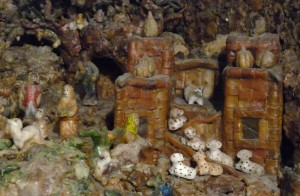 Minn ħin għall-ieħor, il-presepju jkollu xi viżitaturi u Toni ma jonqosx li jagħtihom nagħġa bajda tax-xemgħa bħala tifkira. Intant, meta erġajna sibna ruħna weħidna, hu wrieni l-apparat li bih jaħdem dawn in-nagħaġ, inkluż ukoll il-forom li jagħmel huwa stess.
Minn ħin għall-ieħor, il-presepju jkollu xi viżitaturi u Toni ma jonqosx li jagħtihom nagħġa bajda tax-xemgħa bħala tifkira. Intant, meta erġajna sibna ruħna weħidna, hu wrieni l-apparat li bih jaħdem dawn in-nagħaġ, inkluż ukoll il-forom li jagħmel huwa stess.“Issa li kbirt, dan il-presepju joffrili mezz biex nheda kemmxejn. Fl-istess ħin, fil-ftit siegħat li nkun hawn kuljum, niltaqa’ ma’ nies differenti u ngħid kelma ma’ dak u ma’ l-ieħor.”
(Dan l-artiklu deher fis-sit www.littlerock.com.mt f’Diċembru tal-2014)
Nota: Sfortunatament, illum 6 ta’ Frar 2015, ġejt mgħarrfa li Toni Vassallo żarma dan il-presepju.
-
To die for a piece of bread
Although Carnival is generally associated with fun, exuberance and colour, it was sadness, tragedy and darkness which marked this festive season on 11th February 1823, after more than a hundred children died in Valletta. Details of this terrible tragedy are immortalized in black and white in the Malta Government Gazette of Friday, 14th February 1823 which is archived at the National Library of Malta in Valletta.
Initially, news of this tragedy was recorded as a Government Notice in the Malta Government Gazette (No. 557) by Richard Plasket, Chief Secretary to Government, wherein he declared that an investigation was taking place in order to obtain any possible evidence regarding this fatal accident. A published report of these findings was later annexed as a Supplement (pp. 3391-2) to the same journal of 14th February 1823.
In this long report, Plasket includes information that was provided to him by the Archbishop of Malta, persons examined before the Magistrates of Police which comprised both relatives of the victims and other individuals who were present during this incident, and also a medical report related to this case.
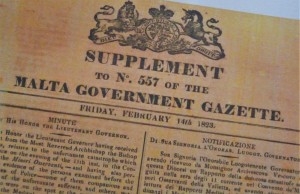 At the beginning of this statement, he furnishes a context for this mishap wherein he mentions that in those years, during the last days of the Carnival celebrations, it had become a tradition to gather a group of boys aged from 8 to 15, who came from the lower classes of Valletta and the Three Cities, to participate in a particular activity. In this event, children who opted to join were taken in a procession to Floriana or elsewhere, and after attending mass, they received some bread which was financed by the Government and other beneficiaries. The main aim of this activity was to protect the children by keeping them out of the riot and confusion of the Carnival that took place in the streets of these cities. The arrangement of this procession was under the responsibility of the Ecclesiastical Directors who taught Cathecism.
At the beginning of this statement, he furnishes a context for this mishap wherein he mentions that in those years, during the last days of the Carnival celebrations, it had become a tradition to gather a group of boys aged from 8 to 15, who came from the lower classes of Valletta and the Three Cities, to participate in a particular activity. In this event, children who opted to join were taken in a procession to Floriana or elsewhere, and after attending mass, they received some bread which was financed by the Government and other beneficiaries. The main aim of this activity was to protect the children by keeping them out of the riot and confusion of the Carnival that took place in the streets of these cities. The arrangement of this procession was under the responsibility of the Ecclesiastical Directors who taught Cathecism.Indeed, according to this tradition, on the 10th February 1823, some children were taken to attend mass at Floriana and were then accompanied to the Convent of the Minori Osservanti in Valletta (today known as the Convent of the Franciscans of St Mary of Jesus or Ta’ Ġieżu) where they were given bread without any difficulty or trouble. The same ritual was intended to take place the day after. Yet no one had any idea that a series of errors would eventually lead to such a great tragedy.
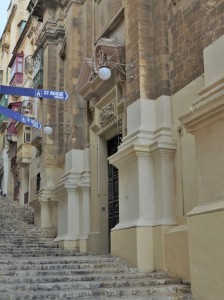 Everything started according to plan on 11th February 1823. The children were gathered in a group and were taken to mass at Floriana. However, when the ceremony lasted an hour longer than usual, the children’s procession to the Convent in Valletta coincided with the end of the Carnival celebrations, when a great number of jubilant people were returning home. This led to the next blunder, as a number of adults and children who were passing by and who knew of this tradition, secretely mixed in with the other boys in order to share the bread which would be distributed.
Everything started according to plan on 11th February 1823. The children were gathered in a group and were taken to mass at Floriana. However, when the ceremony lasted an hour longer than usual, the children’s procession to the Convent in Valletta coincided with the end of the Carnival celebrations, when a great number of jubilant people were returning home. This led to the next blunder, as a number of adults and children who were passing by and who knew of this tradition, secretely mixed in with the other boys in order to share the bread which would be distributed.In line with the usual arrangement, these boys were to enter into a corridor of the Convent from the door of the vestry of the Church, and were to be let out through the opposite door of the Convent in St Ursula Street, where the bread was to be distributed. In order to prevent the boys who received their share from reentering to take a second helping of bread, it became customary to lock the door of the vestry. Yet this time, since the children were late, this door was left open for a longer time so that they could enter. As the sun was setting and darkness crept in, nobody realized that other men and boys who did not form part of the original group were entering too.
Soon, the boys who were queuing in the corridor found themselves being pushed by these trespassers as they forced themselves in. The situation worsened when eventually the vestry door was closed as usual and the children were shoved further at the end of the corridor where a door stood half open so that no one could get back in a second time.
That day was certainly ill-fated when further mistakes continued to occur. In fact, a lamp which was usually lit in the corridor was somehow put out, leaving the overcrowded area in total darkness. This confused the people even more and as they tried to push themselves forward in order to get out, the boys who were at the front fell down a flight of eight steps on top of each other, thereby blocking further the door which happenned to open inwards.
Suddenly, both those who were distributing the bread and the Convent’s neighbours began to hear children shrieking out. They ran to give their assistance but a lot of time was wasted as they tried to open the two doors which led to the corridor in order to reach the people inside.
Eventually, many children were taken out fainting but recovered soon. Others appeared lifeless but were brought to their senses some time afterwards. Regretfully, 110 boys from 8 to 15 years of age perished from suffocation when they were pressed together in such a small place or because they were trampled upon.
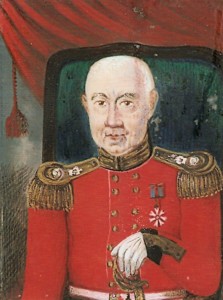 After investigating this accident, the Lieutenant Governor concluded that this was an unfortunate accident caused by the succession of errors mentioned above. Consequently, no one was accused for the death of these children since these acts were not done on purpose to harm them. In fact, Plasket commented that everyone had collaborated to assist these poor boys and even the victims’ relatives had allowed the police and the soldiers to work speedily and diligently in order to save as many children as possible. He insisted that were it not for this, the tragedy could have been much worse.
After investigating this accident, the Lieutenant Governor concluded that this was an unfortunate accident caused by the succession of errors mentioned above. Consequently, no one was accused for the death of these children since these acts were not done on purpose to harm them. In fact, Plasket commented that everyone had collaborated to assist these poor boys and even the victims’ relatives had allowed the police and the soldiers to work speedily and diligently in order to save as many children as possible. He insisted that were it not for this, the tragedy could have been much worse.As I followed further this narrative by focusing on the names mentioned in Plasket’s report, I succeeded to trace the Captain of the Malta Fencibles who led the soldiers during this tragic moment. It was his descendant, Marquis Nicholas De Piro who led me to see Colonel Marquis Giuseppe De Piro’s portrait which is located at Casa Rocca Piccola in Valletta.
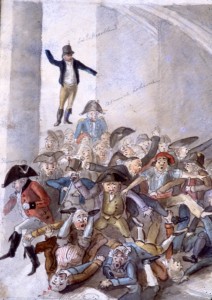 An interesting discussion ensued between us during which the present Marquis informed me also about General Sir George Whitmore who headed the Royal Engineers’ detachment on Malta as its Colonel Commandant between 1811 and 1829. Whitmore had written about his experiences in Malta and had also produced some illustrations related to our islands. Interestingly, Marquis Nicholas De Piro was in possession of a copy of one of these ancient illustrations in the form of a very small slide, which showed some individuals being trampled upon by a group of other people. He wondered whether this slide could be portraying this misfortunate accident of the Carnival of 1823. Yet no children are included in this representation and so it is not clear whether it actually depicts this narrative.
An interesting discussion ensued between us during which the present Marquis informed me also about General Sir George Whitmore who headed the Royal Engineers’ detachment on Malta as its Colonel Commandant between 1811 and 1829. Whitmore had written about his experiences in Malta and had also produced some illustrations related to our islands. Interestingly, Marquis Nicholas De Piro was in possession of a copy of one of these ancient illustrations in the form of a very small slide, which showed some individuals being trampled upon by a group of other people. He wondered whether this slide could be portraying this misfortunate accident of the Carnival of 1823. Yet no children are included in this representation and so it is not clear whether it actually depicts this narrative.My research ended at Ta’ Ġieżu Church and I watched in silence the area where these children lost their lives. Sadness engulfed me when I climbed up the steps on my way back while pondering how these children could end in this way for a piece of bread.
(This article was published in the Carnival Supplement issued with the Times of Malta dated 3rd February 2016)
-
East meets West
For many Western societies, the idea of health is the absence of disease.Yet this is not the case in China, where the aspect of health embodies a comprehensive system that focuses on a balanced lifestyle which is in harmony with nature. Evolving along thousands of years of experimentation and studies about health and longevity, the philosophy of traditional Chinese medicine is today imbued with an ancient wisdom that aims to heal and regenerate not only the body but also the mind and soul.
From 1994, this ideology is being fostered locally by means of The Mediterranean Regional Centre for Traditional Chinese Medicine which is located in Kordin, Paola. Run by a Chinese medical team which changes every two years, this centre has been regularly registering a remarkable increase in Maltese people who attend to receive treatment.
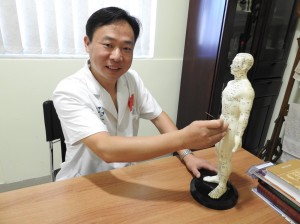 “We are very satisfied with the Maltese people’s response to our services,” remarked Dr Xu Jinhua, the present director of the centre. “In fact, last week, we treated 100 patients.”
“We are very satisfied with the Maltese people’s response to our services,” remarked Dr Xu Jinhua, the present director of the centre. “In fact, last week, we treated 100 patients.”Dr Xu is no new face in this centre since this is the second time that he has joined the Chinese medical team to work in Malta. He was here four years ago and yet he had to undergo again an eight-month preparation programme in Nanjing before coming to our country.
His interpreter, Xiaoyan Sun, described how the team of four Chinese doctors, a chef and herself were required to attend to this outward training in order to be able to provide the best service in Malta.
 “Apart from physical training, our preparation was concentrated on strengthening our ability to communicate in English and learning basic details about Maltese culture and religion. Moreover, all members of the group were familiarized with some general fundamental knowhow to enable us collaborate better. This included learning rudimental information about traditional Chinese medicine in order to be able to co-operate with the doctors, and also getting used to cook so that we could relieve our chef from time to time. Meanwhile, we were also prohibited from visiting home in order to get adjusted to the experience of living in another country, whilst at the same time the group became more like a family.”
“Apart from physical training, our preparation was concentrated on strengthening our ability to communicate in English and learning basic details about Maltese culture and religion. Moreover, all members of the group were familiarized with some general fundamental knowhow to enable us collaborate better. This included learning rudimental information about traditional Chinese medicine in order to be able to co-operate with the doctors, and also getting used to cook so that we could relieve our chef from time to time. Meanwhile, we were also prohibited from visiting home in order to get adjusted to the experience of living in another country, whilst at the same time the group became more like a family.” Genuine dedication and commitment is the order of the day as these four Chinese doctors, who are specialized in acupuncture, provide their services at this centre in Paola, at Mater Dei Hospital, and at Gozo General Hospital. Additionally, as Dr Xu revealed, this team was sent with a further task to set up a Chinese clinic at St Luke’s hospital.
Genuine dedication and commitment is the order of the day as these four Chinese doctors, who are specialized in acupuncture, provide their services at this centre in Paola, at Mater Dei Hospital, and at Gozo General Hospital. Additionally, as Dr Xu revealed, this team was sent with a further task to set up a Chinese clinic at St Luke’s hospital.Diagnosis of traditional Chinese medicine practitioners vary considerably from that of Western doctors.
“From our first glance at the patient, we get a good indication of what the client might be suffering from,” explained Dr Xu. “Immediate tell tale signs are evident in the way one walks, in one’s facial expression and posture, in the colour of the skin, and whether one is thin or fat. Furthermore, a person’s vitality shows through the brightness of the eyes, the colour of the lips, and the state of the hair.”
 It was interesting to discover that much information is also obtained by looking closely at a person’s tongue since its colour, shape and coating reflects the condition of the internal organs.
It was interesting to discover that much information is also obtained by looking closely at a person’s tongue since its colour, shape and coating reflects the condition of the internal organs.“Our investigation includes also auscultation which is done by listening to the patients’ voice, sounds of breathing, and coughing. In the old days, the diagnosis concerned also olfaction; that is smelling the odour of the patient. However today this is somewhat difficult since people use many perfumes and this hides the personal odour of individuals.”
Even pulse-taking is different since the Chinese physician uses three fingers: the index finger to check the heart and lungs, the middle finger to listen to the liver, and the ring finger to test the kidney.
“During this time, the doctor also discusses with the patient about his lifestyle, his diet, whether he practices some form of exercise and if he has any stressful atmosphere at home or at work. This practice takes place in order to see whether the patient is suffering from any sort of imbalance which is resulting in pain. For the treatment to be effective, it is very important that a good relationship is created between the patient and the doctor.”
 Along these twenty-one years, the treatments at this clinic were mainly focused on acupuncture and massage. Yet this year, Dr Xu is keen to introduce a further specialized treatment which involves the use of traditional Chinese herbs.
Along these twenty-one years, the treatments at this clinic were mainly focused on acupuncture and massage. Yet this year, Dr Xu is keen to introduce a further specialized treatment which involves the use of traditional Chinese herbs.“Chinese herbs are used widely in China. There is a vast selection of these herbs, and all have their own particular characteristics and qualities. Their utilization could offer various benefits to the Maltese people. However, till now, we are prohibited from importing these herbs to Malta to treat the locals with them.”
Probably, this restriction is due to the fact that these herbs are alien to our Western doctors. Nonetheless, possibly the time has come to make a change.
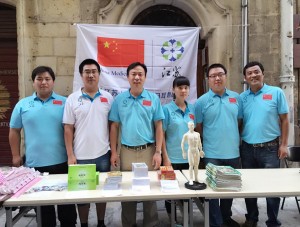 “Last year, I had the opportunity to meet Dr Konrad Mizzi, Minister for Energy and Health, whilst he was visiting some medicine colleges and hospitals in China. At the time, I was glad to see that he seemed very interested in these traditional Chinese herbs, particularly those relating to treat infertility.”
“Last year, I had the opportunity to meet Dr Konrad Mizzi, Minister for Energy and Health, whilst he was visiting some medicine colleges and hospitals in China. At the time, I was glad to see that he seemed very interested in these traditional Chinese herbs, particularly those relating to treat infertility.”“Should treatment with these herbs be allowed in Malta, a Chinese doctor specialised in this sector would be able to attend regularly in our centre in order to diagnose patients and provide treatment. I am aware that presently some people in Malta are using IVF treatment to tackle this issue. Yet in those cases where a couple does not have any problems with the organs themselves, traditional Chinese herbs might offer a less expensive and more reliable natural solution. I must say that in China we have a 70 to 80 per cent success rate for cases of infertility in such situations.”
Dr Xu pointed out that other countries, such as America, have now introduced these methods and they are having very satisfactory results. That is why he is looking very much forward to meet Dr Mizzi in order to discuss further this opportunity.
“If this treatment is made available in Malta, I am sure that many people will benefit from it. Maybe at first, people might be wary or doubtful whether a herb will really be effective. Nonetheless, once people will start obtaining positive results, others will surely follow, and we would be doing a great service to this country.”
(This article was published in ‘Fitness, Nutrition and Well-Being’ Supplement issued with The Times of Malta dated 27th January 2016)
-
WALKING WITH THE DEAD
“As soon as they saw us approaching with our horses, some shop owners hurried to close their doors in order to show us that we were not welcome,” remembered 74 year old, Alfred Mifsud. “This happenned mostly in the villages of Ħal-Kirkop and Safi, and in other areas of northern Malta. It was more a reaction to the sense of disgust which people felt towards our job rather than because of any superstitious fear that we could attract death to their doorstep. In fact, those who did let us in their shops to drink a cup of tea, had a number of reserved cups for us, since other clients would refuse to use them.”
In the old days, it was hard to be an undertaker. Work started from the early hours, when it was still dark, as it took long to prepare the horses and the carriages, and then to drive to church. The deceased was placed in a coffin and was generally carried on the shoulder, from his house to the chapel or church where mass was celebrated in the early morning, so that those who attended, could go to work soon after. In the meantime, the undertakers would stay outside, waiting to carry the coffin to the cemetery.
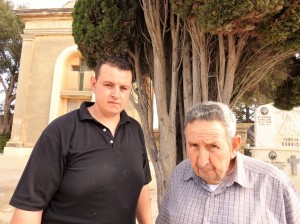 “By that time, after travelling the long road on a hard seat in the cold, we would be yearning for a cup of tea. Yet there were moments when where it not for the kindness of the church’s sacristan, we would be bound to wait for hours before we could drink something warm.”
“By that time, after travelling the long road on a hard seat in the cold, we would be yearning for a cup of tea. Yet there were moments when where it not for the kindness of the church’s sacristan, we would be bound to wait for hours before we could drink something warm.”Certainly, this was a minor discomfort when considering what the rest of the job entailed.
“People might think that undertakers will eventually get used to death and will become numb to the pain which it brings with it. However, they are definitely mistaken because we are often saddened by the suffering, especially when children are somehow involved. How can you remain indifferent when you see parents burying their child or when you hear the cry of the young ones when they see their mum or dad being hauled underground?”
A shudder ran through me and I wondered how anyone could withstand to do such a job.
“You learn to accept death as part of the circumstances of life and consider your job just like any other. You do your duty as best as you can in order to see that everything will run smoothly and that your client is served well.”
When Alfred was twelve years old, he was already assisting his dad, who was also an undertaker, to prepare the deceased for burial. He also gave a hand to other undertakers by helping them out in cemeteries. Even as a child, this work did not upset him and he was never afraid of dead people or burial grounds.
“Our family has been doing this work for more than a century now. It was Lukardu Pace, my father’s uncle, who started a career in this sector, by carrying the dead in funeral carriages. After he died in a traffic accident, my father Fidiel, who is now 93 years old, took over this job, and he introduced us in this work. Eventually it was only me who became a funeral carriage driver besides being an undertaker. However my brothers opened another business which is related to funerals.”
As Alfred began to show me some old photographs of the different funeral carriages that were available at the time, I realized that although death does not differentiate between the rich and the poor, nonetheless, affluent persons still insisted to distinguish themselves from others until the very end.
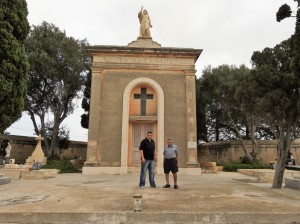 “Prosperous families used the carriage known as ‘tal-prima’ which was very elaborate and richly designed with golden sculpture. It was made of mahogany and it was drawn by four black horses that were adorned with feathers and an elegant pall. Then there was ‘tas-sekonda’ carriage which was made of cheaper painted wood and was accompanied by two black horses. A carriage painted in white and decorated with flowers was utilized to carry dead children and teenagers. In this case, the black horses were dressed with a white pall which was embellished with golden embroidery. ”
“Prosperous families used the carriage known as ‘tal-prima’ which was very elaborate and richly designed with golden sculpture. It was made of mahogany and it was drawn by four black horses that were adorned with feathers and an elegant pall. Then there was ‘tas-sekonda’ carriage which was made of cheaper painted wood and was accompanied by two black horses. A carriage painted in white and decorated with flowers was utilized to carry dead children and teenagers. In this case, the black horses were dressed with a white pall which was embellished with golden embroidery. ”Alas, there was no pomposity reserved for the destitute ones, especially if they had no family. The same thing applied to those who were in trouble with the Church.
“In the past, the Church had a much greater influence on the Maltese society. One was expected to receive the holy communion at least once a year, and a ticket known as ‘bulettin’ was given to those who adhered to this regulation. Those who did not, were not considered as part of the Church, and if they died, they became known as ‘ta’ bla preċett’. No priest would accompany them for their burial, and obviously, no mass would be celebrated. They would simply be carried away in a carriage and were buried in a particular section in the cemetery which was reserved for such people. I remember my father narrating how in such cases, the families of the deceased would insist with him to go and collect the dead relative during the night so that the neighbours will not see what was happenning. Then he would go and wait behind the cemetry’s door in order to be the first to enter once it opens, and hasten the burial before other people are around.”
Alfred remarked that the tradition to celebrate a funeral mass started from the 1970s. Before that period, the family would only organize a short function prior to the burial. In fact, during this time, he used to manage to attend to three or four burials in a day. This was not anymore possible, once funerals included also a longer mass.
“Along my 50-year career, I have witnessed many changes with regards to funerals. Amongst these, I remember many instances where the deceased was accompanied not only by family and friends, but also by members of a religious confraternity. There were also those who paid nuns and orphans from convents of charity in order to attend to their funerals.”
Interesting information kept pouring out as Alfred recalled his long experience in this work. Although happily married to Mary, he still reminisces the difficulty in his youth to find a partner, as many girls considered his work repulsive. Many years have passed from then on and the situation has somehow mitigated. However, Albert, his 29 year old son, who has followed his father’s career, told me that he had the same problem too.
 “I have been fascinated by my father’s work since I was five. Somehow, I was never afraid to help him out in cemeteries and I preferred to be with him than to go to school. Yet, I can understand the discomfort that other people who are not involved in this sector might feel in these circumstances.”
“I have been fascinated by my father’s work since I was five. Somehow, I was never afraid to help him out in cemeteries and I preferred to be with him than to go to school. Yet, I can understand the discomfort that other people who are not involved in this sector might feel in these circumstances.”“By now, I have learnt to take everything in stride, even when I notice some people making superstitious signs at me or at our hearses. There are moments when people make it embarassingly evident that they are uncomfortable with my presence. I remember clearly a particular instance when a person was so perturbed when he saw me waiting behind him in a queue, that he refused to take the rest of the money from the salesgirl and ran out of the shop.”
Just like his father, Albert admitted that when death is always on the order of the day, this job could engulf you with turmoil. Yet throughout these years, he was diligently coached by his father in order to learn how to protect himself from excessive grief, particularly by recognizing the significance of his work in alleviating this burden from the mourning family. Nevertheless, the fear of death is difficult to overcome, even when one faces it so many times.
“Instead of helping you to take death lightly, probably this work might make you perceive the end in a more dreadful way, since you know clearly what awaits you,” Albert said as he smiled nervously.
(This article was published in ‘Man Matters’ Supplement issued with The Times of Malta dated 19th December 2015)
-
A Christmas Nursery
Even as a young child, Paul Pace was very fond of baby Jesus statues. Probably because they reminded him of a number of significant familial moments. His grandma gave him a small wax statue of baby Jesus in order to ease down his sorrow after his father George had to leave for a long time to work with the Navy. On another occasion, his father surprised him when he bought him an expensive statue of baby Jesus that he had longed for, after he succeeded to win a lottery. Now, at 69, Paul owns a collection of more than 2000 of such statues which he has lovingly gathered in a museum that he called ‘Il-Mużew tal-Bambini’.
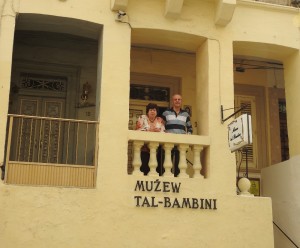 His wife Mary shares his passion and she is always present to give him a hand in this museum which they have purchased together.
His wife Mary shares his passion and she is always present to give him a hand in this museum which they have purchased together.“It is such a pleasure to see people getting emotional when they visit our museum. Some become very nostalgic as they remember their childhood. Others notice some statue which was similar to the one that their parents had, and they start recalling their memories. A number of visitors get inspired to buy a baby Jesus statue of their own, while some others decide to go home and search for their neglected antique statue which their grandma had left them,” Paul said.
Since its inauguration in 2010, il-Mużew tal-Bambini has become quite renowned both with the local and the foreign public. Although it is available for viewing by appointment throughout the year, most of the visitors attend to this museum during the Christmas season.
“There is always something new to see because we are continually adding to our collection. Even though by now, we have a problem with space, when we find a particular baby Jesus statue which we love, we just can’t help not to own it,” admitted Mary.
Certainly, the museum is a wonder to behold. The provenance of the statues is worldwide, thereby providing a rich overview of the different cultures. Skin colour, facial characteristics, and posture of these statues vary accordingly.
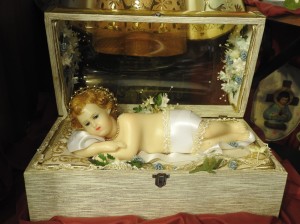 A delicate looking baby Jesus which was made in Malta, rests in a musical box and moves his eyes and hands. A dark skinned baby Jesus made from wood in Tanzania looks exotic amongst the others. A curly black-haired toddler Jesus, wearing the traditional costume of Perù, sits on a chair and weeps after stepping on a thorn, according to a local legend. A wooden statue from Betlehem shows Jesus as a boy dressed as a king and sitting on an elegant throne. A teenage Jesus from Atocia is also resting on a chair, but this time, he wears the clothes of a pilgrim and carries a rod. An intricately adorned statue of Jesus from Trapani is embellished with pomegranate for good luck.
A delicate looking baby Jesus which was made in Malta, rests in a musical box and moves his eyes and hands. A dark skinned baby Jesus made from wood in Tanzania looks exotic amongst the others. A curly black-haired toddler Jesus, wearing the traditional costume of Perù, sits on a chair and weeps after stepping on a thorn, according to a local legend. A wooden statue from Betlehem shows Jesus as a boy dressed as a king and sitting on an elegant throne. A teenage Jesus from Atocia is also resting on a chair, but this time, he wears the clothes of a pilgrim and carries a rod. An intricately adorned statue of Jesus from Trapani is embellished with pomegranate for good luck.“Our interest in this aspect has led us to travel to countries which are related to the life of Jesus, and from which we knew that we could find such statues. Our visit to the Holy Land was an incredible experience which gave us the opportunity to walk in the same roads where Jesus lived. Moreover, it was an ideal country from where to acquire some beautiful statues for our collection,” remarked Paul.
“When we visited Prague, we bought 42 different baby Jesus statues!” exclaimed Mary.
 They just had to, they explained, as they saw my startled reaction. This was because according to an old tradition, the statue of baby Jesus in Prague is dressed in different coloured clothes each day. Therefore, they were bound to purchase a number of statues which showed Jesus in several dresses. Nevertheless, not all the statues bought ended up in the museum, since some of these were presents for family members and friends.
They just had to, they explained, as they saw my startled reaction. This was because according to an old tradition, the statue of baby Jesus in Prague is dressed in different coloured clothes each day. Therefore, they were bound to purchase a number of statues which showed Jesus in several dresses. Nevertheless, not all the statues bought ended up in the museum, since some of these were presents for family members and friends.“Many of those who visit our museum are curious to know whether we can remember all our statues, which of course, we do. We can also recall all the places from where we have obtained these items. Each statue has an interesting story behind it and we love to share them with whoever’s interested to listen,” Paul said.
I was all ears and I felt simply fascinated when their narrative started to pour in. One of these stories entailed how they managed to buy a statue of baby Jesus which belonged to St. Ġorġ Preca. Another was related to an excellent bargain which Mary made unknowingly, when she bought a statue for her husband for a low price, and then found out that it dated to the 18th century. I loved also the account relating to a particular container made of mica which was produced in Malta by a German prisoner of war during World War II, and was utilized to hold a statue of baby Jesus.
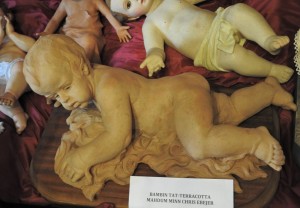 “We have many antique statues but the oldest one that we know the date of goes back to 1730. The smallest statue is about 15mm long, whereas the largest one has a length of 80cms. The materials of these statues varies widely and include: stone, alabaster, marble, woods of different kinds, wax, ceramic, concrete, lava, straw, plastic, wool, and even bull’s horn,” Mary explained.
“We have many antique statues but the oldest one that we know the date of goes back to 1730. The smallest statue is about 15mm long, whereas the largest one has a length of 80cms. The materials of these statues varies widely and include: stone, alabaster, marble, woods of different kinds, wax, ceramic, concrete, lava, straw, plastic, wool, and even bull’s horn,” Mary explained.Yet the strangest was yet to come…
“One day, we had a statue which lost its synthetic hair and we decided to try to replace it with some hair of one of our daughters. The experiment succeeded and soon, we provided the hair to a number of other statues by trimming some hair from our other daughter and eventually also from that of our nephews,” smiled Paul as he pointed them out proudly.
Each time that I observed the statues, I noticed a different one which I had not seen before. The collection looked literally endless, and yet each statue was unique. Whilst some of the statues showed simple features, mostly due to the artistic fashion of the time, others were quite elaborate and pretty. Yet there were also a number of outstanding characters which stood out from the rest.
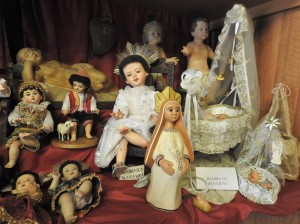 “The main aim of this museum is to share the sweetness of Christmas and the joy which is inherent in each statue of baby Jesus,” revealed the couple.
“The main aim of this museum is to share the sweetness of Christmas and the joy which is inherent in each statue of baby Jesus,” revealed the couple.However, this place offers much more than that since it nurtures love for one’s family, whilst it cherishes an appreciation for diversity. Undoubtedly, this collection is also an invaluable source for those who are interested to study the changes which took place along the years in the production of such precious artworks.
Il-Mużew tal-Bambini which is located at 17, Triq Santa Tereża, Birkirkara, will be open for the public from Sunday, 13th December 2015 to Wednesday, 6th January 2016.
Opening times: Monday to Saturday from 4:30pm – 8:00pm, Sundays and Public Holidays from 9:00am – noon and from 4:30pm – 8:00pm. For more information, one can call 21492111.
(This article was published in CHRISTMAS TIMES Suppliment issued with The Times of Malta dated 8th December 2015)
-
Bats at the museum
As the sun began to set, the sky darkened with the legion of bats which came out of the Rabat catacombs, noted G. Gulia in 1890 in his book Elenco dei Mammiferi Maltesi. Certainly, the tendency of these nightly creatures to live in such dreaded underground areas didn’t help them much in order not to be associated with evil and darkness. Likewise, their strange semblance, their mythical association with Dracula, and images of Satan bearing their wings, hindered even more their reputation. In Aztec and Mayan cultures, bats were deities connected to death. Yet nothing could be far from the truth since bats have a beneficial role in the earth’s ecosystem.
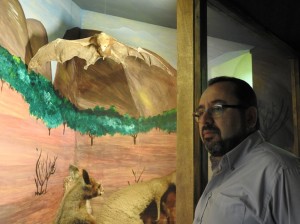 The importance of these unique flying mammals was highlighted during a recent activity which was organized by MEPA’s Environment Division in collaboration with Heritage Malta, at the National Museum of Natural History in Mdina. This annual event, recognized as Malta Bat Night, included a discussion about bats and listening to their sounds through an electronic device.
The importance of these unique flying mammals was highlighted during a recent activity which was organized by MEPA’s Environment Division in collaboration with Heritage Malta, at the National Museum of Natural History in Mdina. This annual event, recognized as Malta Bat Night, included a discussion about bats and listening to their sounds through an electronic device.“Malta Bat Night forms part of a partnership which we have with the European Union for the Research and Conservation of Bats,” explained John Joseph Borg, Senior Curator at the National Museum of Natural History.
“Such events are aimed to inform the public about bats in the hope of removing the negative impression that people have about them. Along the years, bats have decreased considerably in Malta, both because their habitat has often been disturbed, and also due to direct acts of vandalism which were carried out upon them.”
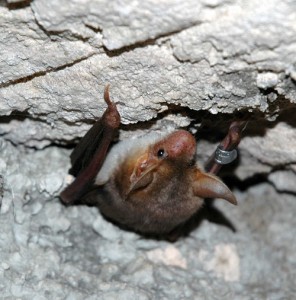 Indeed, Borg explained that colonies of bats have been repeatedly put on fire whilst they were resting in their caves. Others were smothered when vandals threw mud and other things at them, even though they were clearly being protected behind a gate, such as in the case of Ħasan Cave. Bats of a small colony which lived in a site that had access to a particular school, were burnt alive by school children after they captured them and drenched them in hot candle wax.
Indeed, Borg explained that colonies of bats have been repeatedly put on fire whilst they were resting in their caves. Others were smothered when vandals threw mud and other things at them, even though they were clearly being protected behind a gate, such as in the case of Ħasan Cave. Bats of a small colony which lived in a site that had access to a particular school, were burnt alive by school children after they captured them and drenched them in hot candle wax.Well, after hearing these stories, it becomes very clear who the evil ones are.
“Unfortunately our culture has taught us to fear and hate these creatures. In actual fact, their presence could be very advantageous to humans,” revealed Borg.
“Many of the bats eat insects and studies have shown that they tend to feed on species that are harmful to humans and to agriculture. Other small bats which have an elongated snout and a long tongue, act as pollinators when they enter into flower tubes to lick the pollen inside and then move onto different plants. Larger bats, which may look spooky and scary, nurture themselves on decaying fruit and therefore, they keep the fruit trees healthy.”
What about the so called vampire bats. Were they real? And do we have them in Malta?
 “In contrast to peoples’ impression that all bats can suck blood, most of them thrive on insects, fruit, fish and frogs. The only vampire bats which feed on blood are found in South America and they are pretty small. They are nothing similar to the fictional bats that we see in films. In fact, they do not suck blood but they lick it, thanks to their anticogulant saliva which prevents the blood from clotting. They do not normally attack human beings and neither animals. However, they will feed on any animal available if it is reachable to them, including humans.”
“In contrast to peoples’ impression that all bats can suck blood, most of them thrive on insects, fruit, fish and frogs. The only vampire bats which feed on blood are found in South America and they are pretty small. They are nothing similar to the fictional bats that we see in films. In fact, they do not suck blood but they lick it, thanks to their anticogulant saliva which prevents the blood from clotting. They do not normally attack human beings and neither animals. However, they will feed on any animal available if it is reachable to them, including humans.”Borg informed me that we have seven resident species of bats which are: Lesser Horse-shoe Bat (Rhinolophus hipposideros), Maghrebian Bat (Myotis punicus), Grey Long-eared Bat (Plecotus austriacus), Savi`s Pipistrelle (Hypsugo savii), Kuhl`s Pipistrelle (Pipistrellus kuhlii), Common Pipistrelle (Pipistrellus pipistrellus), and Soprano Pipistrelle (Pipistrellus pygmaeus).
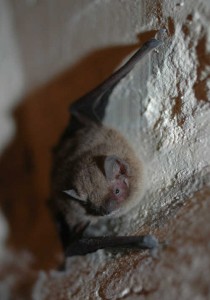 “We have bats from all these resident species living in this museum,” smiled Borg who has an avid passion about bats. “In the underground tunnels there are the Lesser Horse-shoe and the Maghrebian Bats, whereas in the rooms of the underlying level, one finds the Grey Long-eared and the Lesser Horse-shoe Bats. Moreover, all the four Pipistrelle species have managed to make a home in some cracks of the facade and on the high beams.”
“We have bats from all these resident species living in this museum,” smiled Borg who has an avid passion about bats. “In the underground tunnels there are the Lesser Horse-shoe and the Maghrebian Bats, whereas in the rooms of the underlying level, one finds the Grey Long-eared and the Lesser Horse-shoe Bats. Moreover, all the four Pipistrelle species have managed to make a home in some cracks of the facade and on the high beams.”From the remains of moth wings which Borg collects from the museum floor early in the morning for his studies, he is able to identify more information about his resident bats, such as what they prey on. Interestingly, each small Pipistrelle is able to eat around 20,000 moth each night, thereby being more effective than the insect sprays which we use. Nonetheless, most people have no idea about this and when they realize that they are co-habitating with bats, hell breaks lose.
“We do receive calls from people who request us to remove bats from their properties. It is very rare that these creatures enter into homes. Usually they live in cracks in external windows or in narrow openings in facades. Some of the bats are minute in size and in fact, five of them can be placed in a matchstick box. Generally, once these people realize that these animals will be doing no harm to them or to their family, they will agree to allow them to stay. Yet there were cases when the individuals concerned were adamant that they wanted them removed.”
 In such cases, Borg or other responsible officials will need to go and survey the bats before taking action. This involves counting them daily for a whole week in order to confirm the exact amount of bats that are roosting in this place. Once, this amount is identified, they will wait until all the bats are out at night and then they will block the nest in order not to let them in again. Eventually, when the bats will return home and realize what happenned, they will automatically move away to a second area which they tend to keep as a form of protection.
In such cases, Borg or other responsible officials will need to go and survey the bats before taking action. This involves counting them daily for a whole week in order to confirm the exact amount of bats that are roosting in this place. Once, this amount is identified, they will wait until all the bats are out at night and then they will block the nest in order not to let them in again. Eventually, when the bats will return home and realize what happenned, they will automatically move away to a second area which they tend to keep as a form of protection.“This procedure to count bats is very important because they do not always leave the nest in the same number. Usually, a scout bat will fly out first in order to check whether it is windy and whether there are enough insects available in the area. If he returns, the others will stay inside but if he does not, they will understand that the situation is favourable and they will fly out too.”
I couldn’t help feeling impressed by these creatures. Yet more was still to come.
 “The courting and copulation of bats takes place in autumn, between October and November. Then, as soon as the temperature drops and insects are more rare, they will fall in a state of torpidity which is a short period of sleep. During this time, the sperm with which the female has been fertilized will remain stored inside her, waiting for the right moment to come. Once the tempertaure gets warmer and insects become available, these bats will wake up and the real preganancy will start. In this way, both the mother and the offspring will have a better chance to survive.”
“The courting and copulation of bats takes place in autumn, between October and November. Then, as soon as the temperature drops and insects are more rare, they will fall in a state of torpidity which is a short period of sleep. During this time, the sperm with which the female has been fertilized will remain stored inside her, waiting for the right moment to come. Once the tempertaure gets warmer and insects become available, these bats will wake up and the real preganancy will start. In this way, both the mother and the offspring will have a better chance to survive.”Although there are some who associate bats with flying mice, Borg informed me that there is nothing common between the two. While mice come from the order Rodentia, bats form part of the order of Chiroptera (meaning hand-wing).
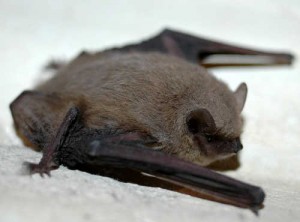 “The oldest bat fossils date back to 55 million years ago where this mammal had already the shape which we know today. On the other hand, the oldest fossils which were found in Malta go back to the Ice Age at around 200,000 and 10,000 years ago. These were found during excavations at Għar Dalam and so we can say that these ancient bats remember the dwarf elephants and hippopotami roaming around. At this museum, we do hold a sample of these fossils. However, the majority of them were taken by the foreign researchers who were doing the excavations, and these passed on their discoveries to their relative museums.”
“The oldest bat fossils date back to 55 million years ago where this mammal had already the shape which we know today. On the other hand, the oldest fossils which were found in Malta go back to the Ice Age at around 200,000 and 10,000 years ago. These were found during excavations at Għar Dalam and so we can say that these ancient bats remember the dwarf elephants and hippopotami roaming around. At this museum, we do hold a sample of these fossils. However, the majority of them were taken by the foreign researchers who were doing the excavations, and these passed on their discoveries to their relative museums.”In the Mdina museum, one can also find some current bat specimens. Borg insisted that it is not the policy of the museum to capture and kill creatures in order to preserve them. So, one won’t find a specimen for each species which live in Malta. Nevertheless, the museum will do his best to assist whoever will request information about bats.
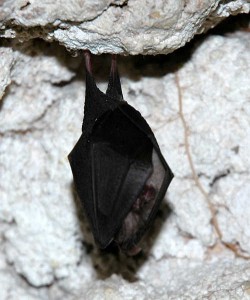 Borg’s own interest in bats goes back to the 1980s. Originally fearful of them, he came face to face with these bats whilst he was doing bird studies and these nightly creatures were being captured accidentally in nets. At first nervous, he asked others to remove them for him, until one day, he decided to do the job himself.
Borg’s own interest in bats goes back to the 1980s. Originally fearful of them, he came face to face with these bats whilst he was doing bird studies and these nightly creatures were being captured accidentally in nets. At first nervous, he asked others to remove them for him, until one day, he decided to do the job himself.From then on, he was completely captivated by them and has been studying them ever since, eager to share his knowledge in the hope of fostering more interest from the public.
It is safe to say that Malta Bat Night has certainly gone a long way towards achieving this.
(This article was published in Escape Suppliment issued with the Sunday Times of Malta dated 29th November 2015)
-
IN SICKNESS AND IN WEALTH
Although today, many societies relate marriage to two persons falling in love with each other, in the past, matters were quite different. Some of the local marriages, especially in wealthy families, were pre-arranged at age seven, in order to ensure that the children will marry a partner at par or even one which could enhance their title and possessions.
Parents were expected to provide their daughters with a dowry as a form of marriage payment and at times, as a kind of anticipated inheritance. Generally depending on the couples’ status and on the type of marriage contract which they adopted, this dowry could either serve to assist the newly-wed to establish a new household, or else to act as a mode of protection against the possibility of ill treatment to the bride by her husband and his family, since in the latter cases, the dowry might have to be returned back. A dowry offered also an element of financial security in widowhood, particularly if there were little children in the family.
The Notarial Archives in Valletta possess a treasure trove of stories connected to marriages and dowries of the past. Thick manuscripts with remarkably detailed records of people who lived hundreds of years ago, encapsulate these significant moments in the elegant writing in black ink and brings them back to life, each time someone opens the old pages and reads.
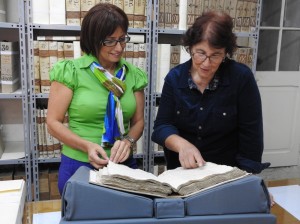 “One of the earliest contracts of marriages which one can find at these archives is dated to 1467. In it, Zullus Calleja from Naxxar is listing the objects which he is forwarding to the groom as a dowry in name of his daughter Jacoba. The form of this dowry is alla Maltese, and that means that the future husband will only be able to administer these possessions but not to sell them without his wife’s consent. However, once their children are born, this dowry will automatically be divided into three equal parts; one belonging to the husband, the other to the wife, and the rest to the offspring. Nevertheless, the children will not be able to utilize these belongings until they reach age 15,” revealed historian Dr Joan Abela.
“One of the earliest contracts of marriages which one can find at these archives is dated to 1467. In it, Zullus Calleja from Naxxar is listing the objects which he is forwarding to the groom as a dowry in name of his daughter Jacoba. The form of this dowry is alla Maltese, and that means that the future husband will only be able to administer these possessions but not to sell them without his wife’s consent. However, once their children are born, this dowry will automatically be divided into three equal parts; one belonging to the husband, the other to the wife, and the rest to the offspring. Nevertheless, the children will not be able to utilize these belongings until they reach age 15,” revealed historian Dr Joan Abela.Together with Isabelle Camilleri, a diligent worker at the Notarial Archives, Abela prepared a display of manuscripts pertaining to different eras so that I could analyze the interesting data within.
“Whilst I was doing some research about marriage contracts in the old days, I discovered that much of them included also a section marked as dos which related to the dowry being given by the father to the groom. Some of these dowries formed part of the inheritance of the bride and therefore it was declared in the contract that the amount which was being given to her during marriage, would be eventually decreased once she inherits her deceased parents. On the other hand, some contracts stated that this dowry was being donated over and above the future inheritance that the woman will have,” explained Abela.
This study shed light also on different types of dowry contracts which were in existence at the same time during various periods.
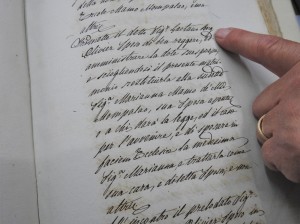 “The most popular ones were the contracts that used the alla Greca or the alla Romana custom, which were practically the same thing. Basically, this type of contract stipulated that all the dowry which was forwarded by the bride’s father to the groom could only be administered by the latter but it could never be alienated without his partner’s approval.”
“The most popular ones were the contracts that used the alla Greca or the alla Romana custom, which were practically the same thing. Basically, this type of contract stipulated that all the dowry which was forwarded by the bride’s father to the groom could only be administered by the latter but it could never be alienated without his partner’s approval.”No matter which style was chosen, all these dowry contracts were quite formal and organized. Experts in each sector of the items being included in the dowry were called upon to evaluate these objects professionally, and their names were included in the contract as a guarantee of genuinity. Ultimately, each of these things were described meticulously in the contract, together with their value at the time.
“Each time that I am working on a new manuscript, I am often delighted at the descriptions that I find. They are so rich in detail that I get the impression of seeing or touching the materials being mentioned, or of smelling the scents and perfumes of the objects in question. I find myself literally in another world as I delve through these pages and read the lists of things that this bride carried with her to her new home,” Camilleri said.
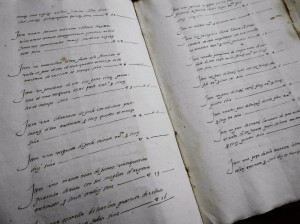 Dowries of affluent people could be quite impressive. One of these which was in the alla Romana style, had a list of more than 60 objects and was dated to 1557.
Dowries of affluent people could be quite impressive. One of these which was in the alla Romana style, had a list of more than 60 objects and was dated to 1557.“There is so much to ponder in this contract,” remarked Abela. “The one who was making the dowry was the renowned knight Marshall Fra Guglielmo Couppier who took part in the Great Siege of Malta in 1565. Interestingly, Victoria, the bride, had been Couppier’s slave but he had given her freedom. Moreover, in this contract, he was also forwarding a substantial dowry in her name, worth of a highly noble woman, to her future husband Hieronomu Debonè who worked as a bombardier and blacksmith.”
Victoria’s dowry included a 20 year old black male slave and a 59 year old female slave, refined jewelry made of gold, precious stones and pearls, clothes made from the most costly materials such as silk, velvet and wool, and mattresses, pillows, bedsheets and blankets of the finest luxury.
“Another type of dowry contract that was available was known as alla Latina. I didn’t find many of these and I noticed that generally they were used by peasants or families who were not so well-off. In fact, the main aim of such contracts was to help the couple initiate a new life together, since otherwise, this would have been difficult. The agreement in such contracts stated that after a year from their wedding, whatever the couple owned, including the dowry which the bride had brought with her, would belong to both of them. And once children were born, these possessions would be divided into three equal parts between the husband, wife and offsprings.”
Unlike the other types of dowry contracts wherein the husband was bound to return all the dowry objects to his wife’s father, in the same good state, or even better, should their marriage fail for any reason or if the woman died before having any children, the couple which chose the alla Latina contract shared both the good and bad times together.
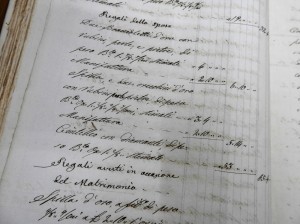 Camilleri led me to another manuscript which dated to the 1860 wherein she showed me a long contract that incorporated an inventory of the dowry of a woman who had died and left three small children behind. Her husband was going to get married a second time and so it was required to specify exactly the origin and value of the deceased wife’s possessions.
Camilleri led me to another manuscript which dated to the 1860 wherein she showed me a long contract that incorporated an inventory of the dowry of a woman who had died and left three small children behind. Her husband was going to get married a second time and so it was required to specify exactly the origin and value of the deceased wife’s possessions.“This dowry included also the gifts which she was given during her wedding,” highlighted Camilleri. “Jewelery made the best part of it and it comprised items made of gold, precious stones, pearls and diamonds. Who gives these gifts in weddings nowadays?”
Up to some years ago in Malta, dowries were still handed over to the newly married couple. Most of these couples were provided with practical items which would be useful in their new home, although some admit that they were given so many things that it was hardly possible to use all of them. In fact, a number of them were still lying in cupboards, brand new.
Although one might still encounter a few Maltese couples from the younger generation whose families are adamant to keep this custom alive, the tradition of providing a dowry of goods is certainly dying out. Yet I tend to believe that the dowry itself has not become obsolete but has merely changed form, possibly into money which could be used by the couple to buy a property or to finance their wedding reception.
(This article was published in the Weddings Supplement issued with The Times of Malta of November 4, 2015)
Travelogue
Archives
| M | T | W | T | F | S | S |
|---|---|---|---|---|---|---|
| « Jan | ||||||
| 1 | 2 | 3 | 4 | 5 | ||
| 6 | 7 | 8 | 9 | 10 | 11 | 12 |
| 13 | 14 | 15 | 16 | 17 | 18 | 19 |
| 20 | 21 | 22 | 23 | 24 | 25 | 26 |
| 27 | 28 | 29 | 30 | 31 | ||
Recent Posts
- A MATTER OF FATE
- MALTA’S PREHISTORIC TREASURES
- THE MAGIC IS IN THE DETAIL
- THE SELLING GAME
- NEVER FORGOTTEN
- Ġrajjiet mhux mitmuma – 35 sena mit-Traġedja tal-Patrol Boat C23
- AN UNEXPECTED VISIT
- THE SISTERS OF THE CRIB
Comments
- Pauline Harkins on Novella – Li kieku stajt!
- admin on IL-KARNIVAL TRAĠIKU TAL-1823
- Albert on IL-KARNIVAL TRAĠIKU TAL-1823
- Martin Ratcliffe on Love in the time of war
- admin on 24 SENA ILU: IT-TRAĠEDJA TAL-PATROL BOAT C23